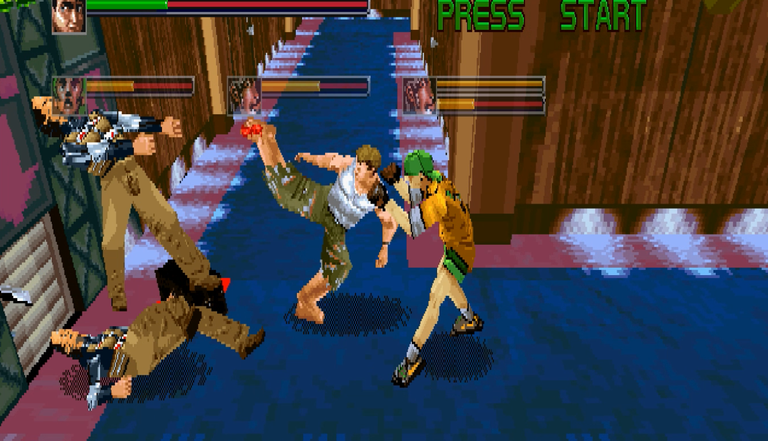

The quotation marks on John McClane will make a bit more sense later on, but for now, you didn't read the title wrong. Or if you thought it was reminding you of a certain movie, then you are not wrong.
This is Die Hard Arcade, a SEGA-made beat-em-up powered by the Sega Saturn based ST-V for arcades, and soon ported to the Sega Saturn proper for the people at home. And yes, it is actually licensed with the name directly from 20th Century Fox [RIP].
But as the SEGA game it is, not only things can get way more hectic than expected, but also isn't actually a game that's...truly related to Die Hard beyond the licensed name.
You see, the original name of this game is actually...Dynamite Deka, which means that it was unrelated, yet obviously heavily inspired by the actual Die Hard movie- which explains how someone had the genius idea at SEGA of America to localize it as a real Die Hard game.
But the name doesn't matter - besides how the sequel would ditch the Die Hard name [Dynamite Cop - the Japanese version went by Dynamite Deka 2], as the game over here or over there is the same otherwise.
Many weapons at reach- if you can get them
You jump in the game and you're already thrown against baddies, with a Punch, Kick and Jump buttons at your arsenal. But as soon as you defeat the first two goons and enter the next room, you'll quickly see that you can knock out and use items like brooms and...handguns to deal with more enemies.
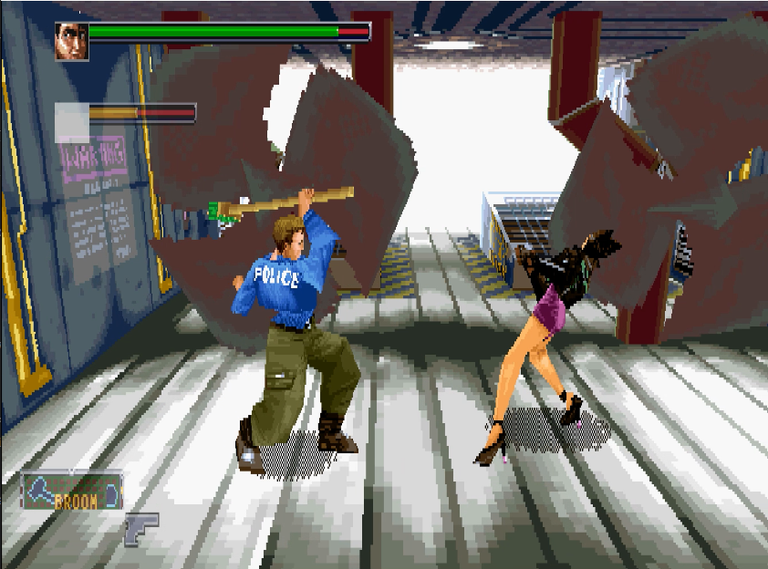
Even bottles of pepper can be used, which makes for a funny sight, and before that, spraycans...that can be used with a lighter for fiery damage if you find a lighter to use it with. But you can still deal damage with spraycans alone.
Die Hard Arcade's first impression with weapons already ramps up quite a bit after that because the room after that has an enemy with A MISSILE LAUNCHER that looks like a huge brick...and yes, YOU CAN PICK UP THE MISSILE LAUNCHER AND USE IT.
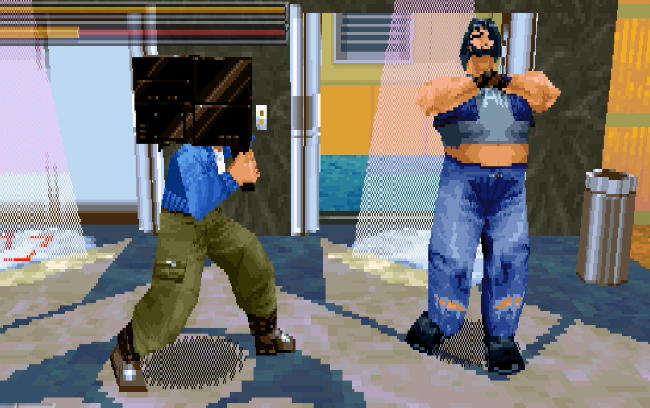
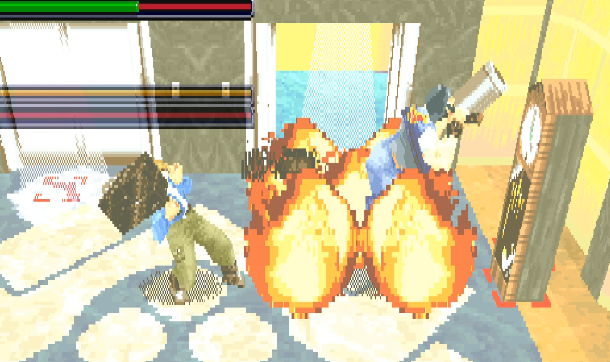
It definitely sets the tone that unlike some other beat-em-ups where the heroes have some moral compass at not using guns specifically [but knifes and anything to be used as a blunt object was A-OK], John and his partner if you play with a second player won't hestitate to pick up any heavy weapon to dish it at the bad guys. And anything that's a weapon to be picked up is conveniently marked.
It got a good chuckle off me the first time, and later on it certainly showed that the game had quite a few ways to get around it as if it were a 2D beat-em-up [specifically due to how you only sidestep up and down as if you were 2D, only being able to run and attack to your sides] along with the weapons.
Reminds me of Cadillacs and Dinosaurs also letting you use missile launchers, except you don't actually explode the bad guys into paste with them nor respawn with one each time you continue with a credit.
...And speaking of credits...
A seemingly short trip...a very deceptive one
While the game only has five levels and can actually be clocked in less than 30 minutes even if you are spending a lot of credits to continue, which is surprisingly short compared to other beat-em-up games, each credit you have only will give you a single bar.
Get knocked out, and that's one credit you need to spend.

And in the Saturn version...by default you only have 4 credits- one which is spent when you start the game. So if you die three times, it's back to the beginning with you.
Speaking from my first experience, as I tried this for the first time today...there's quite a few sneaky things that will easily catch you off guard. For one, at first it might seem that the QTE events are pretty easy to tell when you know they are there, but near the end of the third stage, you get jumpscared with a faster QTE than usual to jump over a missile...or eat it due to your failure.
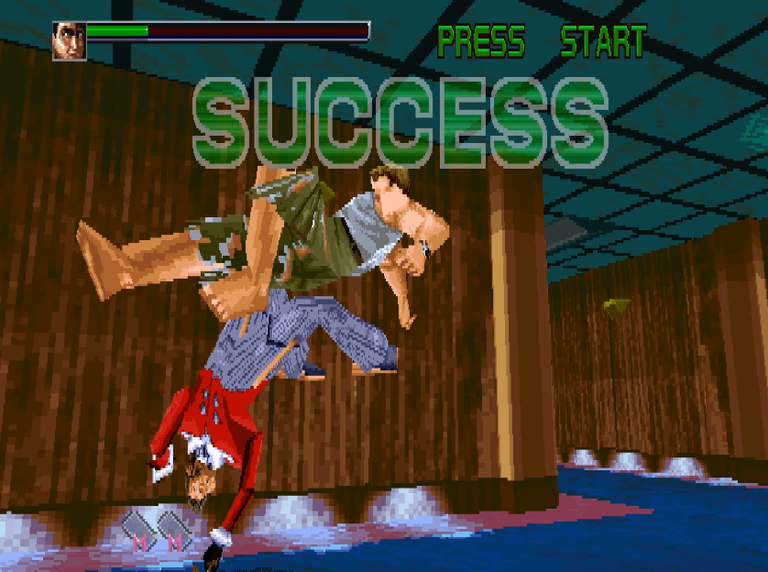
However, the silent killers are the enemies themselves: Some of them can definitely deal a good chunk of damage with a combo or a grab should they get too close to you, which hurts even more knowing that each credit counts. Even when each enemy you beat drops a small health pickup, it is a small pickup, so those are only helpful to gain back your health if you can keep beating enemies without catching another black eye.
There's three things that can help you: The first is strategizing certain enemy quirks, like how they can actually beg for mercy saying [No, No] on the floor but kick you as soon as you turn around, or the armored bad guys in Stage 3 having a permanent gun equipped AND being able to shoot you while prone if knocked down.
The second one is to look up a FAQ [which is literally what I did after three or four failed runs because I couldn't get what to do with the mercy-pleading crooks] to see the movelist and notice that there are quite a few more things you can do with your character than basic punch and kick combos, like jumping and then inputting Up > Down + Punch for a FLYING SHOULDER SLAM that can slam those.
And the third one...I didn't even know of until I was looking at a wiki page for the game and did a double take to read what it said for the game's included minigame.
Gathering more credits for the worse
Before Shenmue brought Hang-On as a bonus if you used the Hang-On cabs in the in-universe arcade center in that game, and before the Yakuza/Like a Dragon games expanded that concept over the years to bring certain long unported games to a modern platform exclusively as a bonus for those games, Die Hard Arcade had an ancient SEGA arcade game called Deep Scan included as a side mode right in the title screen.
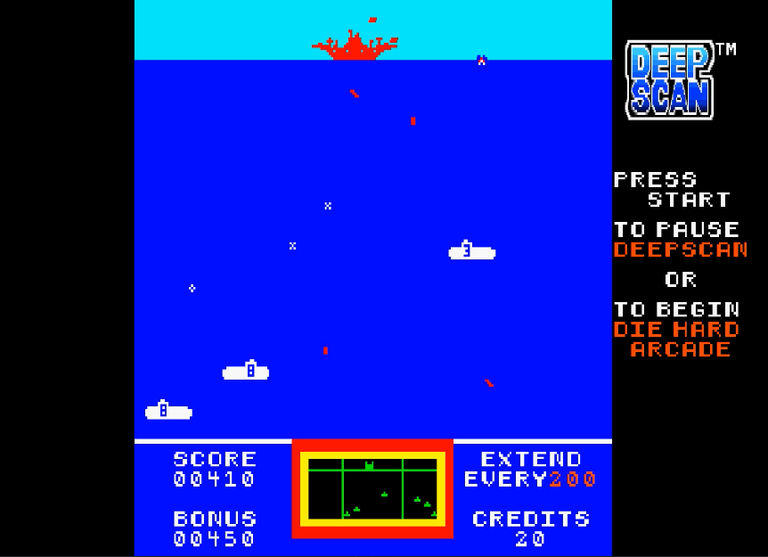
The game is actually pretty straightforward to understand while still entertaining to an extent if you want to aim for a high score...or just want to stock up on credits, which is fairly easy as it only takes 50 to 200 points each for a new credit in Die Hard Arcade.
Yes, while the default credits are quite the strict thing to work with, you can stock up more thanks to this minigame. But if you haven't practiced the later levels, you might get caught off guard HARD by the fireman boss at Stage 5 and even the bald bad boss himself between cutscenes, as even when you are in an one-versus-one against him, he can hurt you BADLY if you leave yourself open to get combo'd by him - as said combos look quite like yours.
Yes, THIS goofy guy can actually kick your unprepared ass handily the moment you have to fight him.
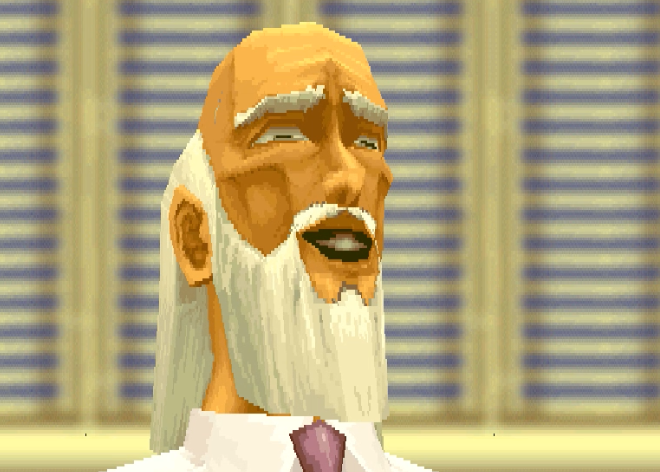
...Which is exactly what happened to me- 10 credits stocked, and after slowly being left with only three credits to spare, and one of those credits being almost instatly wasted by the fireman boss using a grenade that blew up OVER HALF OF MY FULL HEALTH IN A SINGLE MOMENT, couldn't get to defeat the big bad in my second to last session.
So I ended up spending more minutes in Deep Scan just to stock several more credits AGAIN to be able to, at least the next time, see the game until the end even if it cost me a lot of stupid deaths.
And one thing I discovered this time around is that there were golf clubs I could use at the corner and cheese the old man to death.
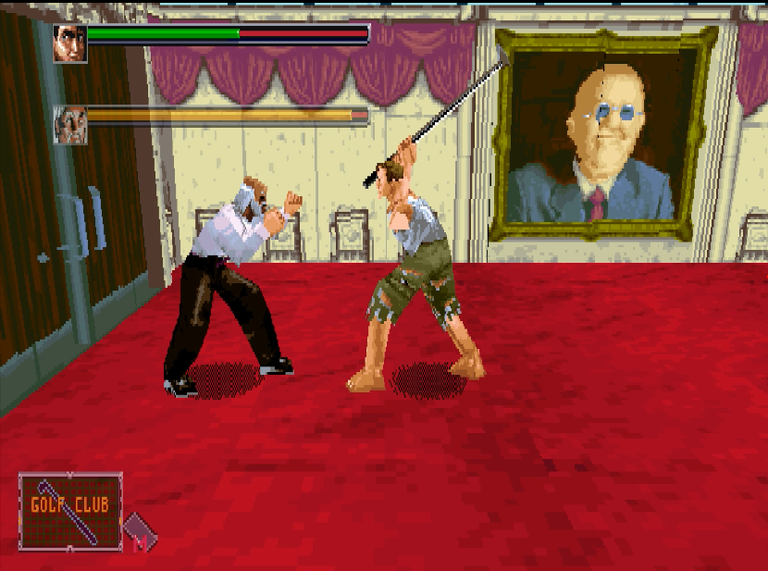
Except turns out he has a second wind as he tried to escape from you, this time shirtless and muscular. This is truly the final battle against him, at long last.
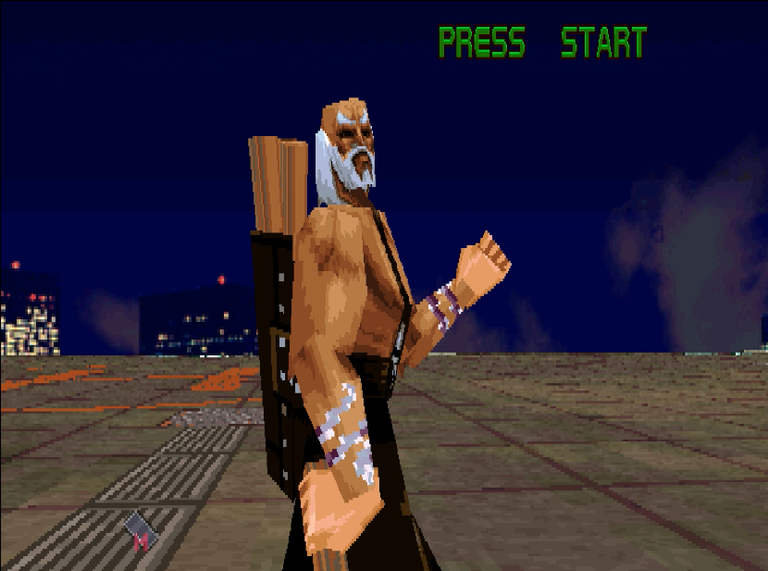
The guy will throw you knives horizontally, vertically, ocasionally block bullets with his sword, and I think there isn't a stray weapon in this final fight for you to cheese him with. It cost me four credits to beat him...
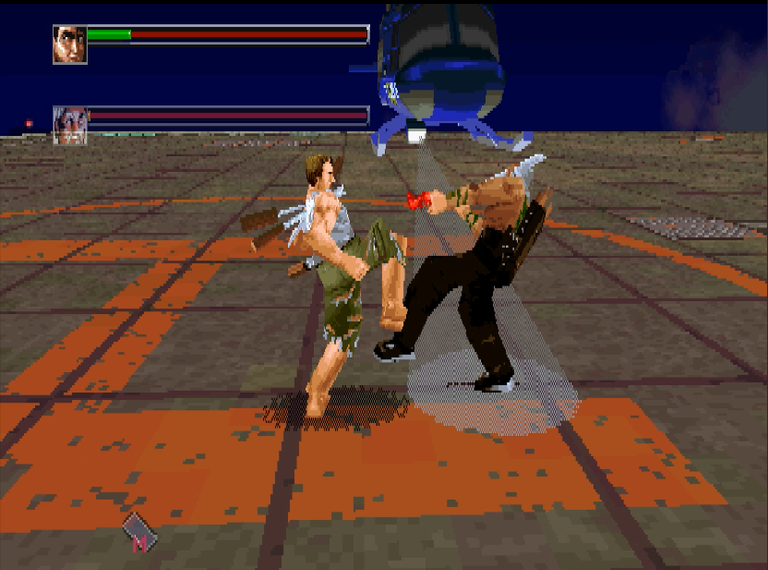
Conclusion
While the music ends up repeating a fair bit between stages, and the game is a real pain to go through if you are aiming for a No Death run or just as few deaths as possible due to some enemies and bosses, as well as how you have to look up on your own the complete arsenal of moves you could try and learn which ones can get you the farthest, Die Hard Arcade is a game that's worth trying out at least once between the over-the-top fighting you can do with the weapons, as well as playing with infinite credits if you emulate the arcade version or stock up credits through Deep Scan in the Saturn version, which can act as a breather between runs.
If you are expecting to get through this one with the default 4 credits, then do yourself a favor, go play Deep Scan for some minutes, and then enjoy the game without having to worry about how many times you'll inevitably die until you make it to the ending.
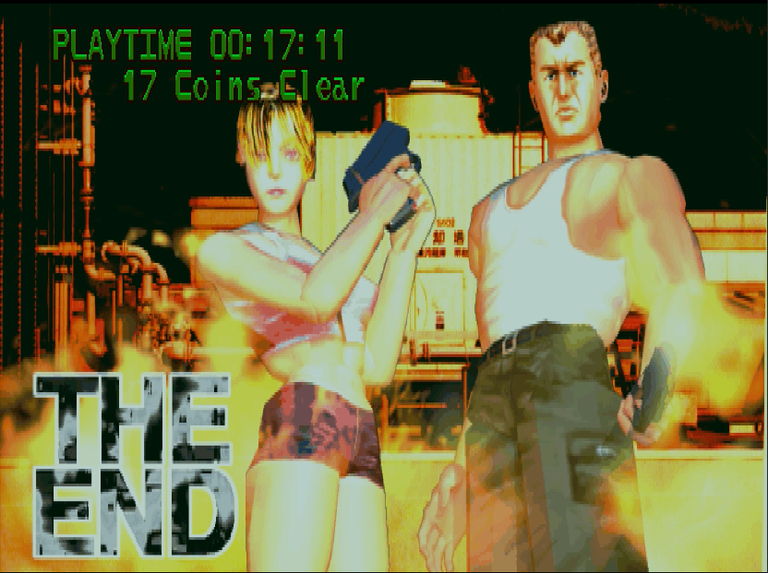
If you are aiming to beat this the best you can with what the game gives you at the start, then best of luck...I don't doubt that there got to be ways with what the game gives you to make a meal out of this game thanks to the short runtime and amount of moves in it.
And of course, there is no better way to end this Die Hard coverage with a Die Hard classic.
Thanks for reading!

Spanish translation with DeepL. All screenshots were captured by myself.
Español

Las comillas sobre John McClane tendrán un poco más de sentido más adelante, pero por ahora, no has leído mal el título. O si pensabas que te recordaba a cierta película, no te equivocas.
Se trata de Die Hard Arcade, un beat-em-up creado por SEGA para placas arcade ST-V basados en la Sega Saturn, y pronto porteado a la Sega Saturn propiamente dicha para la gente en casa. Y sí, en realidad está licenciado con el nombre directamente de 20th Century Fox [RIP].
Pero como juego de SEGA que es, no sólo las cosas se pueden poner más movidas de lo esperado, sino que además no es un juego que esté... realmente relacionado con Die Hard [Duro de Matar / Jungla de Cristál] más allá del nombre de la licencia.
Verás, el nombre original de este juego es en realidad... Dynamite Deka, lo que significa que no tenía nada que ver, aunque obviamente estaba muy inspirado en la película de La Jungla de Cristal, lo que explica que alguien tuviera la genial idea en SEGA of America de localizarlo como un auténtico juego de Die Hard.
Pero el nombre no importa - además de cómo la secuela se desharía del nombre de Die Hard [Dynamite Cop - la versión japonesa fue por Dynamite Deka 2], ya que el juego aquí o allá es el mismo de otra manera.
Muchas armas a tu alcance, si puedes conseguirlas.
Entras en el juego y ya estás lanzado contra los malos, con los botones de Puñetazo, Patada y Salto en tu arsenal. Pero en cuanto derrotes a los dos primeros matones y entres en la siguiente sala, verás rápidamente que puedes golpear y usar objetos como escobas y... pistolas para enfrentarte a más enemigos.

Incluso se pueden usar botellas de pimienta, lo que resulta gracioso, y antes de eso, botes de spray... que se pueden usar con un mechero para causar un daño ardiente si encuentras un mechero con el que usarlo. Pero también puedes hacer daño sólo con los sprays.
La primera impresión de Die Hard Arcade con las armas ya sube bastante de nivel después de eso, porque en la sala siguiente hay un enemigo con UN LANZAMISILES que parece un ladrillo enorme... y sí, PUEDES AGARRAR EL LANZAMISILES Y USARLO.


Definitivamente establece el tono que a diferencia de algunos otros beat-em-ups donde los héroes tienen cierta brújula moral en no usar armas específicamente [pero cuchillos y cualquier cosa para ser utilizado como un objeto contundente era A-OK], John y su compañero si juegas con un segundo jugador no hestitate para recoger cualquier arma pesada para el plato en los malos. Y todo lo que es un arma para recoger está convenientemente marcado.
Me sacó una buena carcajada la primera vez, y más tarde ciertamente demostró que el juego tenía bastantes formas de sortearlo como si fuera un beat-em-up en 2D [específicamente debido a cómo sólo te desplazas hacia arriba y hacia abajo como si fueras 2D, pudiendo sólo correr y atacar a los lados] junto con las armas.
Me recuerda a Cadillacs and Dinosaurs, que también te permiten usar lanzamisiles, salvo que no haces explotar a los malos en pasta con ellos ni resucitas con ellos cada vez que continúas con un crédito.
...Y hablando de créditos...
Un viaje aparentemente corto... muy engañoso
Aunque el juego sólo tiene cinco niveles y en realidad se puede cronometrar en menos de 30 minutos incluso si gastas muchos créditos para continuar, lo que es sorprendentemente corto comparado con otros juegos beat-em-up, cada crédito que tengas sólo te dará una única barra.
Si te noquean, tendrás que gastar un crédito.

Y en la versión de Saturn... por defecto sólo tienes 4 créditos, uno de los cuales se gasta al empezar el juego. Así que si mueres tres veces, vuelves al principio.
Hablando desde mi primera experiencia, ya que hoy lo he probado por primera vez... hay bastantes cosas tramposas que te pillarán fácilmente desprevenido. Por un lado, al principio puede parecer que los eventos QTE son bastante fáciles de distinguir cuando sabes que están ahí, pero cerca del final de la tercera fase, te asustan con un QTE más rápido de lo normal para saltar por encima de un misil... o comértelo debido a tu fallo.

Sin embargo, los asesinos silenciosos son los propios enemigos: Algunos de ellos pueden infligir una buena cantidad de daño con un combo o un agarre si se acercan demasiado a ti, lo que duele aún más sabiendo que cada crédito cuenta. Incluso cuando cada enemigo que derrotas deja caer un pequeño potenciador de salud, se trata de un pequeño potenciador, por lo que sólo son útiles para recuperar tu salud si puedes seguir derrotando enemigos sin volver a tener un ojo morado.
Hay tres cosas que pueden ayudarte: La primera es buscar estrategias para ciertas peculiaridades de los enemigos, como que puedan pedir clemencia diciendo [No, No] en el suelo pero darte una patada en cuanto te das la vuelta, o que los malos con armadura de la fase 3 tengan un arma permanente equipada Y puedan dispararte estando boca abajo si te derriban.
La segunda es buscar un FAQ [que es literalmente lo que hice después de tres o cuatro partidas fallidas porque no conseguía qué hacer con los maleantes que se apiadan de ti] para ver la lista de movimientos y darte cuenta de que hay bastantes más cosas que puedes hacer con tu personaje que los combos básicos de puñetazo y patada, como saltar y luego introducir Arriba > Abajo + Puñetazo para un CODAZO AÉREO que puede golpear a esos en el piso.
Y la tercera... ni siquiera la conocía hasta que estuve mirando una página de la wiki del juego e hice una doble toma al leer lo que decía para el minijuego incluido en el juego.
Gathering more credits for the worse
Antes de que Shenmue trajera Hang-On como bonificación si usabas los taxis Hang-On en el centro arcade del universo de ese juego, y antes de que los juegos de Yakuza/Like a Dragon expandieran ese concepto a lo largo de los años para traer ciertos juegos que llevaban mucho tiempo sin aparecer a una plataforma moderna exclusivamente como bonificación para esos juegos, Die Hard Arcade tenía un antiguo juego arcade de SEGA llamado Deep Scan incluido como modo secundario justo en la pantalla de título.

En realidad, el juego es bastante sencillo de entender, aunque entretiene hasta cierto punto si quieres conseguir una puntuación alta... o simplemente quieres acumular créditos, lo cual es bastante fácil, ya que sólo hacen falta entre 50 y 200 puntos para conseguir un nuevo crédito en Die Hard Arcade.
Sí, aunque los créditos por defecto son bastante estrictos, puedes abastecerte de más gracias a este minijuego. Pero si no has practicado los últimos niveles, puede que te pille desprevenido el jefe bombero de la fase 5 e incluso el propio jefe malo calvo entre las escenas, ya que incluso cuando estás en un uno contra uno contra él, puede hacerte MUCHO daño si te abres a que te haga un combo, ya que dichos combos se parecen bastante a los tuyos.
Sí, este viejo bobo puede patearte el culo si no estás preparado en el momento en que tengas que luchar contra él.

...Que es exactamente lo que me pasó a mí- 10 créditos almacenados, y después de quedarme poco a poco con sólo tres créditos de sobra, y uno de esos créditos siendo casi instantáneamente desperdiciado por el jefe bombero usando una granada que voló MÁS DE LA MITAD DE MI SALUD COMPLETA EN UN SOLO MOMENTO, no pude llegar a derrotar al gran malo en mi penúltima sesión.
Así que acabé pasando más minutos en Deep Scan sólo para volver a acumular varios créditos más para poder, al menos la próxima vez, ver el juego hasta el final aunque me costara un montón de muertes estúpidas.
Y una cosa que descubrí esta vez es que había palos de golf que podía usar en la esquina y matar al viejo fácilmente.

Excepto que resulta que tiene un segundo aire, ya que intentó escapar de ti, esta vez sin camiseta y musculoso. Esta es finalmente la última batalla contra el después de tanto.

El tipo te lanzará cuchillos en horizontal, en vertical, de vez en cuando bloqueará balas con su espada, y creo que no hay un arma perdida en este combate final con la que puedas darle queso. Me costó cuatro créditos derrotarlo...

Conclusión
Aunque la música se repite bastante entre las fases, y el juego es un auténtico suplicio si tu objetivo es no morir o morir lo menos posible debido a algunos enemigos y jefes, además de tener que buscar por tu cuenta todo el arsenal de movimientos que puedes probar y aprender cuáles te pueden llevar más lejos, Die Hard Arcade es un juego que merece la pena probar al menos una vez entre los combates exagerados que puedes hacer con las armas, así como jugar con créditos infinitos si emulas la versión arcade o abastecerte de créditos a través de Deep Scan en la versión Saturn, que puede servir de respiro entre partida y partida.
Si esperas pasártelo con los 4 créditos por defecto, hazte un favor, vete a jugar a Deep Scan unos minutos, y luego disfruta del juego sin tener que preocuparte de cuántas veces morirás inevitablemente hasta llegar al final.

Si tu objetivo es superar esto lo mejor que puedas con lo mínimo que te da desde el principio, entonces mucha suerte... No dudo que tiene que haber formas con lo que el juego te da de hacer una comida de este juego gracias a la corta duración y la cantidad de movimientos en él.
Y por supuesto, no hay mejor manera de terminar esta cobertura de Duro de Matar con un clásico de Duro de Matar.
¡Gracias por leer!

Traducción al español hecha con DeepL. Todas las fotos capturadas por mí.
Honestly, while this was an awesome experience in arcades, it was definitely less fun at home after having dropped $50 for it at EB (I picked it up on discount for $20 and still feel ripped off slightly).
This was the beginning of the end for Sega for most. They spent TONS to get that license then put it on this game. Fans of the movies were not happy about only the name being connected and beat em up fans were upset that this game wasn't longer. Nothing new beyond the mini game was added to the Saturn port.
Sega didn't do anything to make the game longer, better, or well anything other than port the arcade game to the Saturn with minimal effort beyond that.
That is where I think Sega started losing fans. Over on PlayStation, Sega's biggest arcade challenger, Namco, were adding TONS of things to their home ports. Namco was raising the bar for home ports of arcade games and they were doing it on PlayStation. Even Capcom added did extra, even if ever so slight, with their home ports of Street Fighter II and such during the 32-Bit era.
Sega on the other hand, well, we got the bare bones port, for full price, of an arcade game that could be beaten with 1/10th investment of the home version. It wasn't just Die Hard. Sega did this with Daytona Racing, Sega Rally Championship (okay, they did a bit more than normal with this port), and Sky Target to name a few.
Sadly, Sega continued this with the Dreamcast all the while Namco and many others were going above and beyond with their arcade to home ports. Even those licensed from arcade game makers and released by another company in the home did more than Sega were doing.
I love Sega arcade games, they are focused fun events but straight ports to the home don't make sense, not at full price.
SEGA arcade games are technically easier to revisit and replay now as the usual method of accessing them is...the easiest method overall if you know what to do and where to get what you need [because most of their catalog hasn't been ported to modern consoles if not at all - again, if you want Fighting Vipers 2 or Daytona USA 2 on consoles, you have to buy Like a Dragon Gaiden and/or Infinte Wealth], at least both in not having to shell out full price for those and infinite credits if playing arcade games through emulation.
That said, it is interesting to hear this account from you regarding how things about SEGA were seen back in the day [as someone born in 2002...so definitely way after SEGA's hardware prime] - caught my eye that you happened to name Sky Target [even if Daytona USA's name was off] as that was one game I kinda know from emulating the arcade version but know that was ported to the Saturn.
There's certainly a few games that had additional bonus and modes, such as Virtual-On having the Jaguarandi hidden boss unlockable, SEGA Touring Car Championship having a separate Saturn mode with a few extra modes [although some Saturn ports in general had a Saturn mode that was allowing you to use a few different cars or an altered story mode], SEGA Rally Championship didn't have an extra campaign mode like SR2 but did have the unlockable Stratos and Time Attack modes, and Daytona USA Championship Circuit Edition had a few extra tracks and cars to choose from while being totally remade from scratch.
It is kind of tragic to think that, while nowadays it is easier to appreciate these games for what they are, it makes sense to think that arcade ports without much meat in them on a console already struggling overseas was really rough compared to PS1 getting games ranging from slightly or noticeably feature rich arcade ports...to games like Final Fantasy VII and Metal Gear Solid that need no introduction in regards to how big they were in single player. And that's not talking about super solid single player games in Saturn that already were sharing house with the PS1.
The Dreamcast did have some bigger and more ambitious games, but it is hard to argue that even if it had even stronger games than what it launched with [and Saturn hadn't stopped the steamrolling they had with the Sega Genesis], the PS2 was just too much to compete with overall. Even the Gamecube, which is beloved in my heart to this day, ended up THIRD behind the Playstation 2 and Xbox in sales - so the Dreamcast even has less of a chance.
Perhaps this is why they have decided to often go with the Yakuza ports route - even to the annoyance of arcade enthusiast wanting to only get the rare arcade game ports, it obviously happens to be easier to sell those inside whole ass games rather than as collections. And not saying that it isn't possible [Marvel vs Capcom Collection is thriving]...but for SEGA arcade titles specifically is far more niche of an idea to bank on outside of Japan.
There's certainly some interesting food for thought in this topic specifically, but it was neat to see someone articulate that much their point of view about that in here - apologies for the even longer reply, you can tell this was quite the fun thought for me as someone that didn't grow in the 90s BUT spent many years messing around with SEGA PC ports from the internet...most of which were based off the Saturn ports 😅
I was born in 1976, I was enjoying Sega arcade ports throughout gaming and it was an amazing feeling to be able to play almost arcade perfect arcade games on the Saturn (I was BIG into arcades at that time too). It just sucked that Sega was wanting $50 for these ports, I understand development is not cheap and people need to be paid but fans voted with their dollars and in cases like this, at least in my circle of friends, PlayStation won almost every time.
I would bring up Daytona (my apologies on getting the name wrong, I am going off memory here) and my friends would point out Ridge Racer. Virtua Fighter 1 and 2 were countered by Tekken. Sky Target was countered with Warhawk (not an arcade port but still even a blind man could see how amazing that was back then).
Adding extras, advertising those extras, would have done so much for Sega but they were horrible at this. They peaked with their advertising with the Sega Genesis and the "Welcome to the Next Level" campaign as it was all downhill after that.
Another area they completely and utterly failed their fanbase was no 2D or 2.5D Sonic on Saturn. Instead we got Clockwork Knight 1 and 2 (mags of the time made sure to point out this was ONE game in Japan) and Bug 1 and 2 (Too). Astal gets a pass here as it was simply beautiful back then.
Sega came into the 32-Bit race ahead of schedule and fans like me thought they did this because they had a new Streets of Rage, Comix Zone, X-Men, Sonic, Phantasy Star, etc ready to go and would drop them closer to the launch of PlayStation six months or so later. Sadly, history shows us, this was not the case and Sega was traversing rough waters with no manning the helm of the ship.
Virtua Fighter Remix was what the original release should have been on Saturn with "arcade visuals" being an option, even make the Remix an unlockable if need be.
I would love to see Sega do a Super Scaler (Space Harrier, Thunder Blade, Super Hang-On, etc) collection even if they only improved the frame rate. The value of a collection would be in the number of games for the price rather than added content or unlockables. Sadly, back in the Saturn days, Sega passed on doing just this with their Sega Ages series and instead we had Working Designs step in to release one with three games on it (After Burner was one, I remember definitely being included).
The Dreamcast had a good amount of 3rd party support, Capcom were kicking up a lot of dust with their support for Sega's last console. Sadly, it was either ahead of its time or was the victim of how Sega ended the Saturn (which did cause EA to snub the DC).
The Dreamcast was a nice farewell to hardware manufacturing for Sega. It is sad but looking back on it, it appears that is exactly what it was meant to be. Sega poured development money into their releases on this console and pushed hard (if only they pushed this hard on the Saturn) but as you mentioned, the PS2 was just too strong an opponent to take on. Sony did so much right by gamers with the 32-Bit generation that it would be near impossible to crack that support Sony had before they even released the next PlayStation console.
A long time ago (I was about 12 years old), in a place in the city where I live there was an Arcade place, I remember that there were a lot of machines and I remember that there was one in particular where there was a certain queue and that was about this Die Hard game. I only played it once and I didn't like it, maybe it was too small for the gameplay but the truth was that I played it only once and that was it. I didn't want to play it anymore.
What I did understand is that I didn't understand how there were so many people queuing up and spending so much money in tokens to play this game.
Probably it was popular for teenagers and older folks because it had the Die Hard name attached to it - arguably people that were intrigued to see the name of a movie they must have watched around that time being in the arcades to play with. In that regard, it makes a lot of sense that people flocked around it...although it certainly it isn't the most polished beat-em-up you could get your hands on the very first time [Streets of Rage 2 is probably still the most solid retro beat-em-up ever made by SEGA].
On the other hand, if you want to talk about people queueing up on games that didn't seem or didn't actually happen to be of great quality beyond the way they looked and sounded at the time, remember that Midway's Pit Fighter, even if nowadays it does look really janky, was a cash printer in arcades as people apparently went to play it a lot...perhaps due to the digitized sprites that were done years before they ended up making Mortal Kombat.
Although the worst part you could get from such case is to buy an even worse port of an already janky game [The game would already look less impressive in the Genesis...but if you had the SNES version, then you were stuck with a complete mess]- or if you are a home owner and still were able to get a home perfect port, the idea that you may have paid full price for something that doesn't quite add up to the hype at home [and the price] must be pretty sour.
It is what triverse was mentioning in his comment on this post [the detail about arcade-to-home ports with little to no extra modes costing full price like AAA games do today...and in this game's case the Saturn port doesn't even have ANY difficulty settings nor extras- just the game and a minigame], and in that regard, it does sound like quite a feeling to go through.
There was a PS2 remake of this game with remade graphics that included an Easy Mode, a Saturn visuals mode and two extra modes which was apparently a cheaper release, but was exclusive to Japan. It is kind of weird but maybe understandable in hindsight how SEGA had released a bunch of standalone arcade titles in Japan for the PS2, and while 9 of those SEGA Ages releases made it as a collection overseas, the rest of ports were stuck as import-only.
TL;DR: Probably the same that can happen with some games today: Big recognizable name, graphics that impress people [DHA's probably did at the time] and people just willing to shell as much as possible to go through the game they saw as a really cool game.
If that hadn't worked back in the day, then stuff like microtranscations appearing in the 2010s and Sony pushing out a solely visual-fidelity-focused hardware upgrade in the form of the 700+ dollar priced PS5 Pro...but as you know now, those did 😅
Thanks for reading and for your comment :]